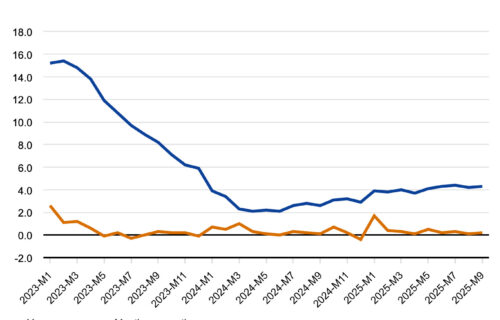Consumer prices in Slovakia rose faster in September, with inflation edging up to 4.3% year-on-year — the second-highest level recorded this year, just behind July’s 4.4%. The increase was driven mainly by higher fuel and beverage prices, as well as persistent cost growth in restaurants, cafés, and canteens. However, food and housing prices showed signs of moderation, providing some relief to households.
Month-on-month, consumer prices grew by 0.2%, marking a slight acceleration compared to August. According to the Statistical Office of the Slovak Republic, price growth was registered in eight of the twelve monitored expenditure categories, with the steepest rise of 3.7% in the education sector, coinciding with the start of the new school year. The most significant increases were observed in secondary education fees, up by 8.6%, while kindergarten, primary, and language course fees also climbed.
The catering and hospitality sector recorded the third-highest increase of the year, with prices up 0.9% overall. Canteen meal costs rose by 2.3%, and restaurant services also saw steady increases. Meanwhile, bank fees pushed prices in the miscellaneous goods and services category up by 0.7%, reflecting a 3.8% rise in financial service costs.
On the other hand, food prices fell for the first time in five months, down 0.4% month-on-month, thanks to lower costs of vegetables (-2.5%), confectionery (-1.5%), and bread and cereals (-0.4%). Meat and cooking oils were also cheaper, although milk, cheese, and eggs became more expensive. Non-alcoholic beverages rose by 0.9%, continuing their upward trend.
Transportation costs decreased by 0.4% overall, as air travel became more affordable despite rising fuel and passenger transport prices. A similar 0.4% decline occurred in recreation and culture, mainly due to cheaper package holidays and office supplies.
Compared to September 2024, prices were higher in all twelve expenditure groups. Education saw the strongest growth at 9.8%, followed by restaurants and hotels, and financial and insurance services. Transport prices increased 4.2% year-on-year, reversing several months of declines, as rising fuel prices once again began to push inflation higher.
Food and non-alcoholic beverages — which account for the second-largest share of household spending — rose by 3.6% annually, a slower pace than in previous months. Within that category, milk, cheese, and eggs jumped more than 9%, while bread and cereals rose 1.6%. Vegetable and fish prices fell, while non-alcoholic beverages surged more than 20%, marking a record increase.
Core inflation, which excludes volatile and regulated items such as energy and taxes, stood at 3.6% in September, while net inflation — excluding food prices as well — was 3.5%. Month-on-month, both indicators showed modest increases.
For the first nine months of 2025, overall inflation averaged 4.1%. Despite the slight acceleration in September, analysts note that the broader inflation trend remains moderate compared to the peaks of 2023, when food and energy prices surged amid global market instability.
Source: SOSR
